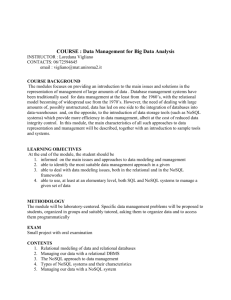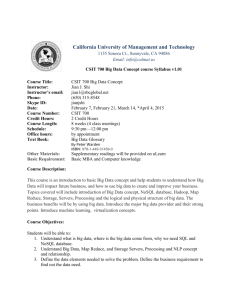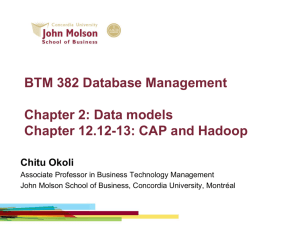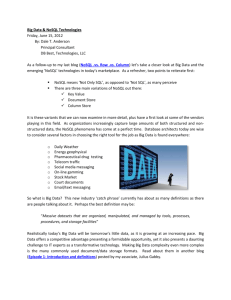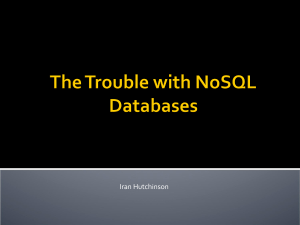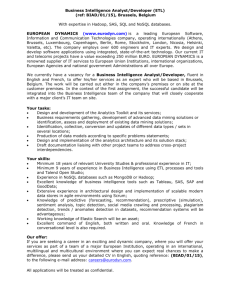Big Data and NoSQL - Faculty Web Server
advertisement
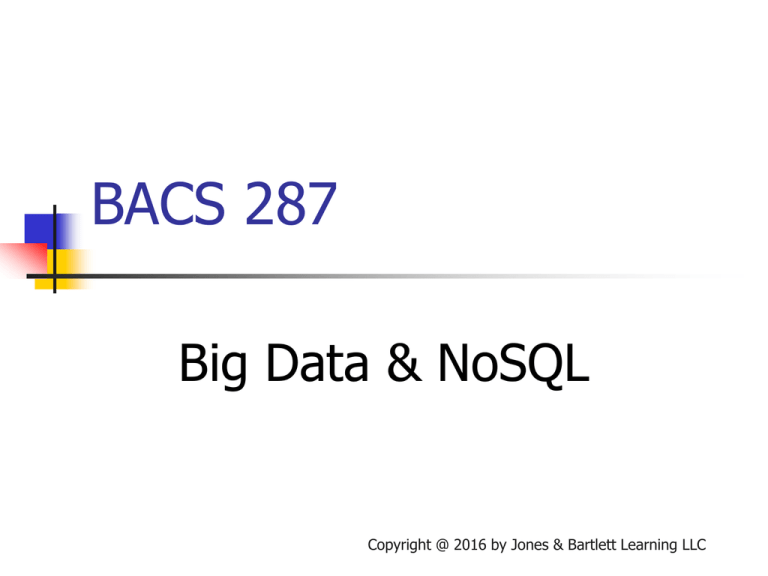
BACS 287 Big Data & NoSQL Copyright @ 2016 by Jones & Bartlett Learning LLC Motivation for Big Data The amount of data that is collected by many organizations has grown at an unprecedented rate The size of data collected exceeds the capacity of most RDBMS products Data collected is not typical of the type found in relational tables: Unstructured Generated in real-time May not have a well-defined schema Varying types: pictures, video, social media posts, sensor data, purchase transactions, cell phone data Big Data Statistics 2.5 quintillion bytes of data generated every day 90% of the world’s data generated since 2012 570 new web sites every day The amount of data is doubling every year and expected to reach 40,000 exabytes by the year 2020 (40 trillion gigabytes of data) The ability to handle data of this magnitude requires new approaches to data management and query processing Big Data Applications Facebook: Collects over 500 terabytes of data every day Netflix: Collects over 30 million movie plays per day (rewinds, fast forwards, pauses) and 3-4 million ratings and searches to use for recommendations Energy Companies: Collect and analyze large amounts of data to analyze the reliability and status of the power grid Seattle Children’s Hospital: Analyze and visualize terabytes of data to reduce medical errors and save on medical costs IBM Watson Computer System: Accessed 200 million pages of data over four terabytes of disk storage to win the Jeopardy quiz show in 2011 The “5 Vs” of Big Data Figure 12.1 The Five Vs of Big Data Using Big Data The big data research community characterizes the process of using big data as a pipeline. Data Collection Extraction, Cleaning, and Annotation Integration, Aggregation, and Representation Analysis and Modeling Interpretation of Results Figure 12.2 The Big Data Pipeline Hadoop: Background Framework that initiated the era of big data Invented by Doug Cutting and Mike Carafella in 2002 at University of Washington (originally known as Nutch) Was revised to become Hadoop after the publication of key papers by Google: 2003 paper on the Google File System 2004 paper on MapReduce Hadoop became an open-source Apache Software Foundation project in 2006 Provides storage and analytics for companies such as Facebook, LinkedIn, Twitter, Netflix, Etsy, and Disney Hadoop Backbone Hadoop Distributed File System (HDFS) A system for distributing large data sets across a network of commodity computers Can be complex to manage distributed file components and metadata Provides a high level of fault tolerance Supports parallel processing for faster computation MapReduce parallel programming model Designed to operate in parallel over distributed files and merge the results Map: Filters and/or transforms data into a more appropriate form Reduce: Performs calculations and/or aggregations over data from the map step to merge results from distributed sources Overview of Hive Hive is built on top of Hadoop, providing traditional query capabilities over Hadoop data using HiveQL Hive is not a full-scale database, providing no support for updates, transactions, and indexes Hive was designed for batch jobs over large data sets HiveQL queries are automatically translated to MapReduce jobs Queries demonstrate a higher degree of latency than queries in relational systems Operates in schema-on-read mode rather than schema-on-write mode as in relational systems Schema-On-Read vs Schema-On-Write Schema-On-Write (traditional database systems) User defines schema Creates DB according to the schema Loads data Data must conform to the schema definition Schema-On-Read (Hive) Data is loaded into a file in its native format The data is not checked against a schema until it is read through a query Users can apply different schemas to the same data set Fast data loads but slower query execution time Data Organization in Hive Hive data is organized into: Databases: Highest level of abstraction; serves as a namespace for tables, partitions, and buckets Tables: Same concept as tables in RDBMS Partitions: Organizes a table according to the values of a specific column; Fast way to retrieve a portion of the data Buckets: Organizes a table based on the hash value of a specific column; Convenient way to sample data from large data sets HiveQL HiveQL is an SQL interface that supports ad-hoc queries over Hive tables HiveQL is a dialect of SQL-92 and does not support all features of the standard Syntax is similar to the SQL syntax of MySQL HiveQL queries are automatically translated to MapReduce jobs Designed for batch processing and not real-time processing SQL Features Not Supported by HiveQL No row level inserts, updates, or deletes No updateable views No stored procedures Caveat: SORT BY will only sort the output of a single reducer; Use ORDER BY to get a total ordering of the output from all reducers NoSQL Systems HDFS was designed for batch-oriented, sequential access of large data sets Many applications that access big data still have a need for real-time processing of queries, as well as row-level inserts, updates, and deletes NoSQL systems were designed to meet these additional needs for big data applications Many NoSQL systems are built on top of Hadoop as a storage system for big data Origins of NoSQL The term NoSQL was first used by Carlo Strozzi in 1998 when he built a relational database that did not provide an SQL interface In 2004, Google introduced BigTable, which was designed for: High speed, large data volumes, and real-time access Flexible schema design for semi-structured data Relaxed transactional characteristics BigTable has become the basis for several column-oriented NoSQL products Today, NoSQL is often interpreted as meaning “Not Only SQL” since many products provide SQL access in addition to programmatic access The RDBMS Motivation for NoSQL RDBMS technology has several shortcoming with respect to largescale, data intensive applications RDBMS was design primarily for centralized computing Handling more users requires getting a bigger server Sharding is used to partition data across servers Expensive, with limits to server size Not easy to change Complex to maintain Difficult for query processing and updates Rigid with respect to schema design ACID properties of data transactions are restrictive, with more focus on consistency than performance The Role of NoSQL Systems NoSQL systems were designed to address the needs of large-scale, data intensive, real-time applications NoSQL is not a replacement for RDBMS technnology NoSQL can be used in a complementary fashion with RDBMS technology, to handle the needs of modern, Internet-scale applications that have grown beyond the capacity of traditional, transaction-oriented data technology. Features of NoSQL Technology Store and process petabytes of data in real time Horizontal scaling with replication and distribution over commodity servers Flexible data schemas Weaker concurrency model Simple call level interface Parallel processing NewSQL Systems Many financial and business applications that handle large amounts of data cannot afford to sacrifice ACID properties of transactions NewSQL systems are a developing alternative to NoSQL and RDBMS technology NewSQL systems exploit distributed database technology together with cloud computing to handle big data together with transactional capabilities that support ACID properties
